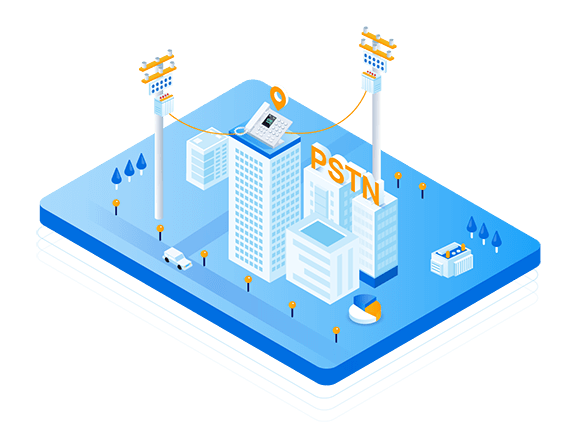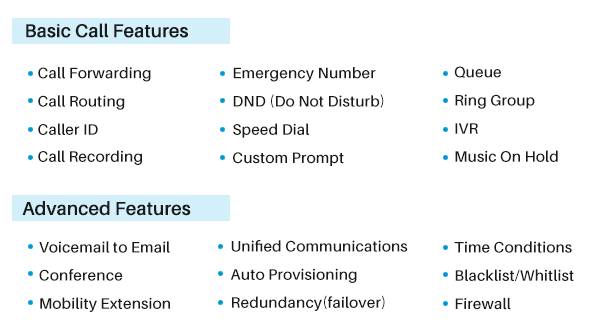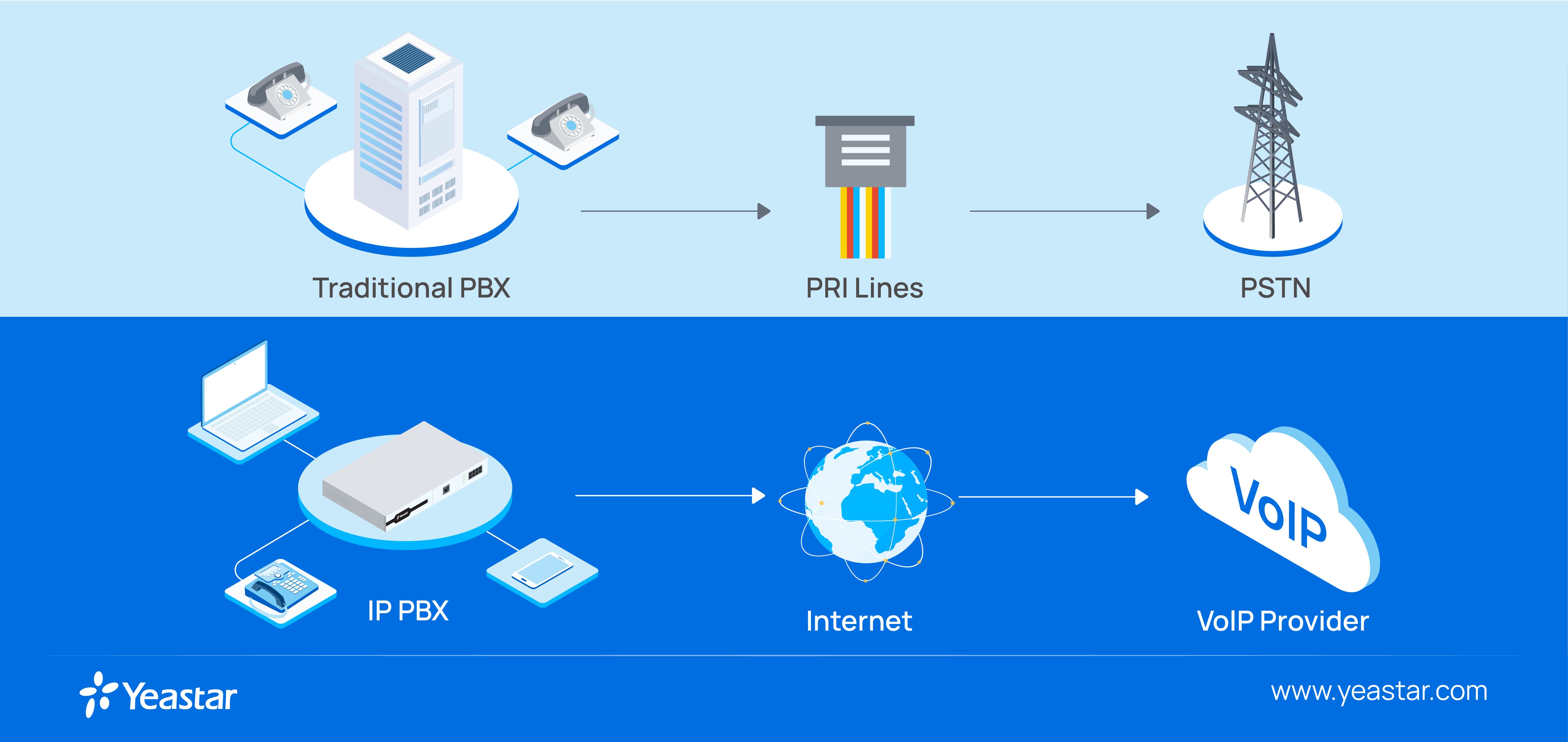
What can you learn from this blog:
- What is PSTN? →
- What are the history of PSTN →
- How Does PSTN Line Work? →
- What Is a Plain Old Telephone Service? →
- What are the Pros and Cons of PSTN phone system? →
- How much does a PSTN-based phone system cost? →
- Alternatives of PSTN for Businesses →
- Switch to VoIP to Improve Business Efficiency →
What is PSTN (Public Switched Telephone Network)?
PSTN stands for Public Switched Telephone Network. It is the traditional and widely-used global telecommunications network. It enables voice and other forms of communication to be transmitted over copper wires, fiber optic cables, and other mediums. Operated by telecom service providers, the network includes landline telephones, fax machines, and other devices that connect to the public telephone system.
PSTN provides reliable and high-quality voice communication services to millions of users worldwide. With the rise of Internet-based phone systems like Voice over IP (VoIP), the relevance and usage of PSTN have decreased. Nevertheless, it still serves as a critical infrastructure for many essential services, including emergency calls and backup communication systems.
History of Public Switched Telephone Network
The first voice transmission was conducted using a single wire that connected two devices. Since there were no sounds, people had to whistle to get the attention of the person on the other end. Later, a bell was added to notify the receiver of an incoming call.
With the advance of technology, people wanted to have a phone in every household. However, it was not possible to establish so many wires between buildings. This is when the control center appears. Whenever somebody was calling, the call would first reach a centralized office, and then the operator would connect the wires in the switch and pass the call to its destination.
Those switches run by operators have been later replaced to analog and then digital switches. Voice signals changed to digital voice signals making the voice quality clearer even at a long distance. PSTN had new features like forwarding and holding a call and joining the conference calls.
How Does PSTN Line Work?
The Public Switched Telephone Network, PSTN, needs a number of things to work: switching centers, satellite and fiber optic cables, cables systems, cellular networks, and telephone lines.
Simply put, PTSN works by converting your voice into digital signals. These signals travel through a network of copper wires, fiber optics, and satellites. Along the way, switching centers direct the call to the recipient’s phone, whether they are nearby or far away. When the call is answered, the digital signals are converted back into sound, allowing you to talk in real-time.
What Is a POTS (Plain Old Telephone Service)?
Plain Old Telephone Service (POTS) is closely related to the Public Switched Telephone Network (PSTN). The only difference between POTS and PSTN is that the latter can use other materials (e.g., fiber), and the former is the traditional “plain” telephone network for voice calls.
When you dial a number on your smartphone or traditional phone, the telephone networks connect you to the receiver, whether they are nearby or overseas. The tones you hear are actually electrical signals sent through copper wires.
POTS requires circuits to remain open during a call. This is because the signals must reach the other end of the circuit and continue until the person you are calling answers. The further the call, the longer it takes for the signals to travel, making long-distance calls more expensive due to the extended time the circuits must stay open.
When you call a company, such as a call center, insurance provider, or home service provider, they often use a Private Branch Exchange (PBX). A PBX is a switch that directs your incoming call to any available phone within the company. This allows the business to have one phone number with multiple extensions and numerous lines. The same switch is used when an employee makes an outbound call from the company.
The Pros and Cons of PSTN Phone Systems
Advantages of PSTN
Reliability
Public Switched Telephone Network is a long-used technology that has been developed all around the world. PSTN doesn’t depend on the Internet connection, which means even if you have frequent network crash or power outages, your company can continue answering and making calls.
Security
PSTN network is almost impossible to hack into since it has dedicated underground copper wires. Thus, telephone communication is very secure and reliable for businesses and individuals.
Usability
The PSTN system is very easy to use at work, especially for people who are not familiar with new technologies. You will have basic features of forwarding and muting a call, leaving a voicemail, and putting it on hold, and these options aren’t hard to learn.
Disadvantages of PSTN
Price
The cost of using PSTN for personal use is low because you only need a subscription for your traditional phone. However, for businesses, the costs are much higher. Each employee needs their own line, and installing these lines and paying the phone bills can be expensive for a small business.
Additionally, businesses need to buy a PBX (Public Branch Exchange). A PBX keeps all the company numbers in one place and routes external calls internally. While it is easy to use, it is expensive to install and maintain. You will need a separate room to house it and an IT professional to handle any issues.
Limited Phone Calls
Your business will have to pay for calls, or there can be an option of purchasing a package with minutes. In any case, if you need to make calls abroad, it can be quite costly.
Lack of Advanced Features
For some companies, the basic features are enough; however, they are not sufficient for others. As the modern workforce becoming more agile, unified communications is going to be the next of norm, which PSTN cannot support. It also falls short in terms of equipping remote working employees to stay connected with colleagues and customers.
How much does a PSTN-based phone system cost?
The cost of PSTN access can vary widely depending on several factors such as your location, service provider, and specific needs. Here’s a general breakdown:
Initial Installation Costs
If you were to install a new PSTN phone system today, you would have to pay an installation fee for technicians to come and set up the lines. And everyone inside your office need a phone, which means you have to purchase purchase a separate line for each employee.
Monthly Charges
The monthly cost depends on your PSTN provider. You need to pay for the basic line rental according to their monthly rental plans. Based on your usage, you will also need to pay for call charges, with long-distance or international calls often costing more than local calls.
Additional Features
Telephony services like voicemail, caller ID, and call forwarding may require additional fees.
Maintenance Costs
Ongoing expenses for system upkeep and repairs.
Alternatives of PSTN for Businesses
Some companies find PSTN as outdated and limited, and they prefer to switch to more modern alternatives-VoIP.
ISDN vs. PSTN
Before VoIP, ISDN used to be an alternative for PSTN.ISDN stands for Integrated Services Digital Network, which also utilizes circuit switching technology and transmits both voice and data over the same wire, while PSTN can only transfer voice. The other advantage of ISDN is that it has better voice quality and faster exchange compared to the Plain Old Telephone Service.
ISDN was developed after PSTN in 1991 and was used by the public a year later. It is popular among large businesses because of its speed and quality. Apart from those benefits, ISDN can have two connections (phone, video, fax, data) simultaneously.
However, with telecommunications providers shutting down the service globally, the era of ISDN has come to an end.
VoIP vs. PSTN
VoIP (Voice over Internet Protocol), also known as IP telephony, allows you to make calls over the Internet. Unlike ISDN and PSTN, VoIP doesn’t rely on a circuit-switched phone system but rather uses an Internet connection, making it an ideal alternative for small businesses.
Here is a short video to help you understand VoIP is in a minute:
PSTN (Public Switched Telephone Network) sends voice signals over wires, while VoIP converts audio into data packets and then back to audio when it reaches the recipient.
Feature Comparison
- VoIP offers a range of advanced features that cater to sophisticated business needs. In addition to basic functions like muting, forwarding, and holding calls, VoIP enables instant messaging, voicemail, video conferencing, and more.
- PSTN primarily supports traditional voice communication with limited additional features.

Portability
- PSTN lines are physically connected to the office, limiting mobility.
- VoIP can be used anywhere with a reliable Internet connection. Employees can use their mobile phones or computers as office extensions, allowing them to take business calls from anywhere in the world.
Cost
- VoIP installation is typically much cheaper than PSTN because it doesn’t require physical lines or proprietary phones. This cost-effectiveness makes VoIP particularly attractive to startups, as it allows them to connect employees globally and leverage useful key metrics provided by Internet telephony.

Switch to VoIP to Improve Business Efficiency
Public Switched Telephone Network is a traditional landline that has been used for years by businesses and individuals. While PSTN ushers modern communications, as technology evolving and the becoming matured and stabilized, VoIP has gradually become the best choice for communication systems.
Based on VoIP, Yeastar phone system is designed to provide a full suite of unified communications solution for small and medium-sized businesses. Yeastar offers features from must-have to nice-to-have for enterprise-class communications, such as UC Clients,Call Center, CRM integration, Video Conferencing, Instant Messaging, Softphone, etc.
If you are looking for a versatile unified communications system that suppots onsite, remote, and mobile workforce. Yeastar could be your go-to option. Sign up for 30-day FREE trial to experience for yourself.



This was a really informative post! I had heard about PSTN before, but I didn’t fully understand how it worked or its benefits compared to VoIP. The breakdown of both systems was super helpful. I’m definitely considering the VoIP free trial now to see how it fits my needs! Thanks for sharing!
Hi Smash,
Thank you for your message. If you want to the VoIP ferr trial, please clink here: https://www.yeastar.com/cloud-pbx-free-trial